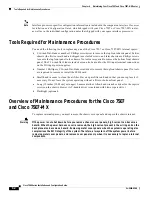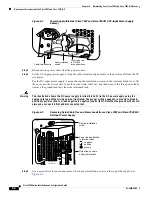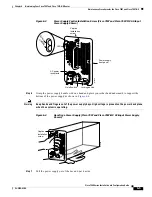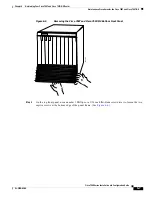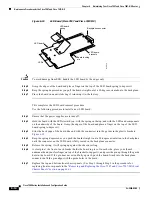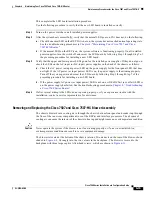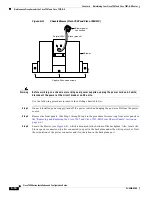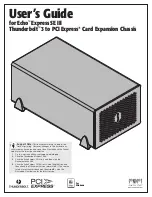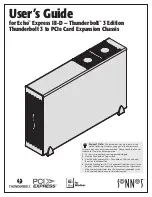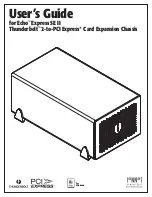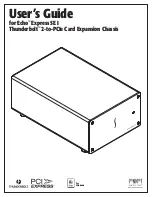
6-10
Cisco 7500 Series Installation and Configuration Guide
OL-5008-03 B0
Chapter 6 Maintaining Your Cisco 7507 and Cisco 7507-MX Router
Maintenance Procedures for the Cisco 7507 and Cisco 7507-MX
Cleaning and Replacing the Cisco 7507 and Cisco 7507-MX Air Filter
In the Cisco 7507 and Cisco 7507-MX, the air filter removes dust from the air drawn in by the blower.
The edges of the air filter fit into the lower frame of the top front chassis panel. You should remove and
vacuum the air filter at least once every 2 weeks, or more often in unusually dusty environments. If
vacuuming is not possible, you can remove the filter and wash it, but ensure that it is completely dry
before replacing it in the chassis. Have spares on hand in case the filter tears or becomes worn. A dirty
filter can prohibit the flow of cooling air into the chassis and might cause an overtemperature condition.
If you can remove, clean, and replace the filter within 5 minutes, you do not need to shut down the system
power.
Caution
Do not operate the system for more than 5 minutes without a filter installed. Never place a wet filter in
the chassis; the moisture drawn into the chassis can damage the equipment.
You need to remove the bottom front chassis panel to access and remove the filter, and then move the
filter away from the chassis for vacuuming. Vacuuming can dislodge substantial amounts of dust, and
cleaning the filter near the opened chassis can allow loose particles to enter the chassis through the
unfiltered blower. Therefore, we recommend that you briefly remove the panel to clean it, and then
immediately replace it in the chassis.
Use the following procedure to check the air filter and clean or replace it if necessary:
Step 1
Remove the bottom front panel. (See Step 1 through Step 6 in the procedure for removing front cover
panels in the
“Removing and Replacing the Cisco 7507 and Cisco 7507-MX Front Chassis Panels”
section on page 6-6
.) The edges of the air filter fit into the lower frame of the top front panel.
Step 2
Remove the filter by grasping it in the center and pulling the edges out of the frame.
Step 3
Check the condition of the filter. If the filter is extremely dusty, or if it appears worn or torn, discard it
after you ensure that you have a replacement available. Proceed to Step 7 to install the new filter.
Step 4
Move the filter away from the chassis and vacuum it thoroughly. Do not vacuum the filter when it is
installed or near the chassis opening; doing so can dislodge substantial amounts of dust and allow loose
particles to enter the chassis.
Step 5
If the filter needs washing, refer to Step 7 to install a temporary replacement filter. If a replacement is
not available, shut down the system until the filter dries and you can safely replace it.
Step 6
Wash the filter in running water, or discard it and replace it with a new filter. The filter must be
thoroughly dry before you replace it in the chassis.
Step 7
Place the new or clean, dry filter (or a temporary replacement filter) over the frame and push the edges
into the frame with your fingers. Ensure that all edges are tucked into the frame.
Step 8
Replace the bottom front panel by aligning the bottom of the panel with the holes on the front of the
chassis. Push the edges in until the ball studs snap into place.
Caution
Never place a wet filter in the chassis; the moisture drawn into the chassis can damage the equipment.







